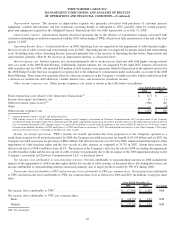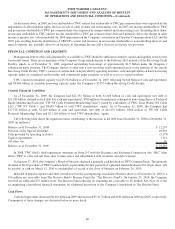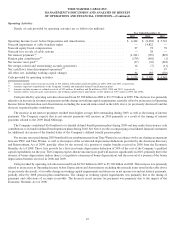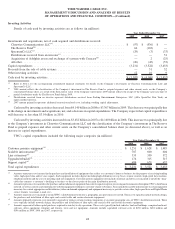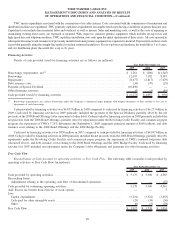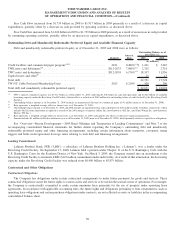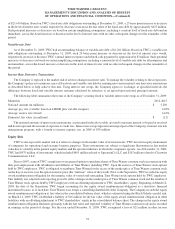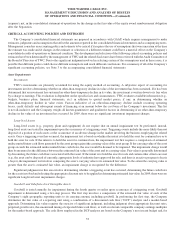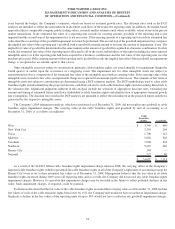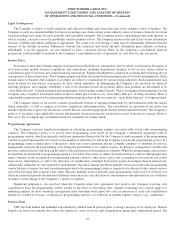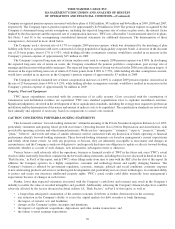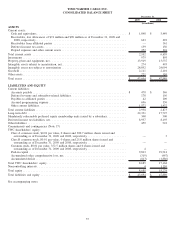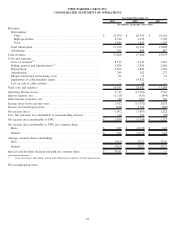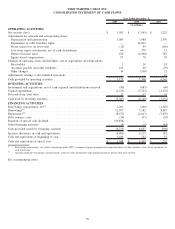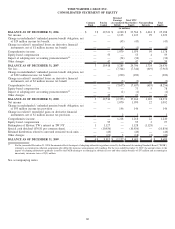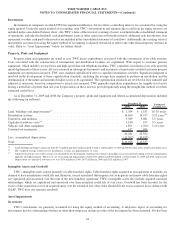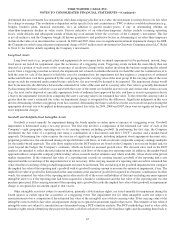Time Warner Cable 2009 Annual Report Download - page 67
Download and view the complete annual report
Please find page 67 of the 2009 Time Warner Cable annual report below. You can navigate through the pages in the report by either clicking on the pages listed below, or by using the keyword search tool below to find specific information within the annual report.Legal Contingencies
The Company is subject to legal, regulatory and other proceedings and claims that arise in the ordinary course of business. The
Company records an estimated liability for those proceedings and claims arising in the ordinary course of business when the loss from
such proceedings and claims becomes probable and reasonably estimable. The Company reviews outstanding claims with internal, as
well as external, counsel to assess the probability and the estimates of loss. The Company reassesses the risk of loss as new information
becomes available and adjusts liabilities as appropriate. The actual cost of resolving a claim may be substantially different from the
amount of the liability recorded. Differences between the estimated and actual amounts determined upon ultimate resolution,
individually or in the aggregate, are not expected to have a material adverse effect on the Company’s consolidated financial
position but could possibly be material to the Company’s consolidated results of operations or cash flow for any one period.
Income Taxes
From time to time, the Company engages in transactions in which the tax consequences may be subject to uncertainty. Examples of
such transactions include business acquisitions and dispositions, including dispositions designed to be tax free, issues related to
consideration paid or received, and certain financing transactions. Significant judgment is required in assessing and estimating the tax
consequences of these transactions. The Company prepares and files tax returns based on interpretation of tax laws and regulations. In the
normal course of business, the Company’s tax returns are subject to examination by various taxing authorities. Such examinations may
result in future tax and interest assessments by these taxing authorities. In determining the Company’s tax provision for financial
reporting purposes, the Company establishes a reserve for uncertain income tax positions unless such positions are determined to be
“more likely than not” of being sustained upon examination, based on their technical merits. That is, for financial reporting purposes, the
Company only recognizes tax benefits taken on the tax return that it believes are “more likely than not” of being sustained. There is
considerable judgment involved in determining whether positions taken on the tax return are “more likely than not” of being sustained.
The Company adjusts its tax reserve estimates periodically because of ongoing examinations by, and settlements with, the various
taxing authorities, as well as changes in tax laws, regulations and interpretations. The consolidated tax provision of any given year
includes adjustments to prior year income tax accruals that are considered appropriate and any related estimated interest. The Company’s
policy is to recognize, when applicable, interest and penalties on uncertain income tax positions as part of income tax expense. Refer to
Note 12 to the accompanying consolidated financial statements for further details.
Programming Agreements
The Company exercises significant judgment in estimating programming expense associated with certain video programming
contracts. The Company’s policy is to record video programming costs based on the Company’s contractual agreements with its
programming vendors, which are generally multi-year agreements that provide for the Company to make payments to the programming
vendors at agreed upon market rates based on the number of subscribers to which the Company provides the programming service. If a
programming contract expires prior to the parties’ entry into a new agreement and the Company continues to distribute the service,
management estimates the programming costs during the period there is no contract in place. In doing so, management considers the
previous contractual rates, inflation and the status of the negotiations in determining its estimates. When the programming contract terms
are finalized, an adjustment to programming expense is recorded, if necessary, to reflect the terms of the new contract. Management also
makes estimates in the recognition of programming expense related to other items, such as the accounting for free periods and credits
from service interruptions, as well as the allocation of consideration exchanged between the parties in multiple-element transactions.
Additionally, judgments are also required by management when the Company purchases multiple services from the same programming
vendor. In these scenarios, the total consideration provided to the programming vendor is required to be allocated to the various services
received based upon their respective fair values. Because multiple services from the same programming vendor may be received over
different contractual periods and may have different contractual rates, the allocation of consideration to the individual services will have
an impact on the timing of the Company’s expense recognition.
Significant judgment is also involved when the Company enters into agreements that result in the Company receiving cash
consideration from the programming vendor, usually in the form of advertising sales, channel positioning fees, launch support or
marketing support. In these situations, management must determine based upon facts and circumstances if such cash consideration
should be recorded as revenue, a reduction in programming expense or a reduction in another expense category (e.g., marketing).
Pension Plans
TWC has both funded and unfunded noncontributory defined benefit pension plans covering a majority of its employees. Pension
benefits are based on formulas that reflect the employees’ years of service and compensation during their employment period. The
55
TIME WARNER CABLE INC.
MANAGEMENT’S DISCUSSION AND ANALYSIS OF RESULTS
OF OPERATIONS AND FINANCIAL CONDITION—(Continued)


